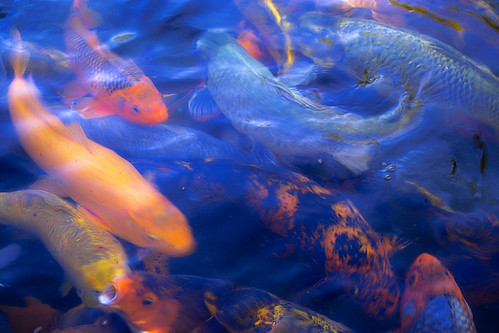How to Breed Koi Fish
Published by Nanni on Monday, October 29, 2012
Photo credit by spyzter
If you’re already a fish enthusiast, you might know that a happy koi could be with you for 30 years. However, you might not realize that the record in Japan for koi longevity is 223 years.
The koi sold in the United States come in a rainbow of colors. They’re the offspring of several centuries of crossing the common brown Asian carp with selected German carp. You can buy a koi that’s pure white, yellow, orange, red, blue, almost lavender, green, coal black or various combinations of colors. The price runs from several dollars all the way to hundreds of thousands for the most exotic fish. If you’re interesting in breeding koi, here are some tips on the basics.
Choosing the parents
Ideally, a koi male should be between three and five years old. The prime age for females is between four and six. You’ll need to condition them for a year by keeping them healthy and well fed. The fish should go through a hibernation cycle of several months during which you stop feeding them. By spring, love will be in the air—or water, in this case.
Place two males for every female in a spawning tank. Using a segregated area for reproduction helps ensure genetics of the fish. Males have spots on the pectoral fins and develop gill covers. Females have larger abdomens.
Setting up the spawning area
The first thing the fish need to reproduce is a place to lay their eggs, known as media. They also require privacy, the right pond temperature and the proper water quality.
A good choice for media is a piece of yarn attached to a cork and suspended in water. Other options are evergreen branches tied together or grass growing at the bottom of the pond. You can also buy artificial media. Also keep in mind when selecting media that the fry will need a place to rest in safety before they’re able to swim.
The right temperature to breed koi is upper 60s to lower 70s. Some experts consider 68 degrees optimal.
Acceptable water quality means plenty of oxygen and good aeration. You’ll also need to use a very fine mesh as a barrier to small fry going through your filter. Once the fish have spawned, you’ll be able to smell when it’s time to replace water. If you disturb spawning koi, they’re likely to stop the process.
Eggs and fry
Because they’re uncommonly sticky, koi eggs adhere easily, and could start growing a fungus-like substance. Good eggs will appear translucent. Those that look white and fuzzy are unfertilized. It’s now time to remove either the adult koi or the eggs from the water so that mature fish don’t eat the eggs and fry.
Once the fry have hatched, you should avoid feeling them for three or four days. Experts then suggest feeding them natural foods like daphnia or brine shrimp. If you need a food source while tracking down either of these, use boiled egg yolk. The water should remain between 70 and 75 degrees.
A month after hatching, you should start culling the fry. Two or three weeks later, you should repeat the process and feed them more high-protein foods.
Breeding and raising koi can be almost an art for fish fanciers. Beginners, however, should concentrate on the basics.
 | Posted in »
| Posted in »

0 comments: Responses to “ How to Breed Koi Fish ”